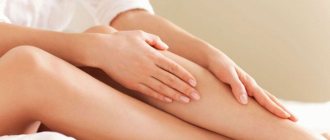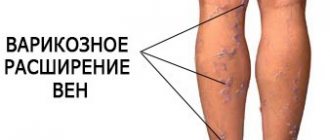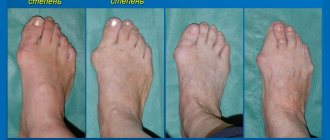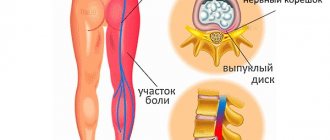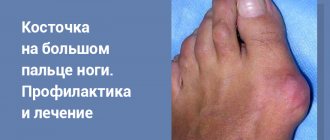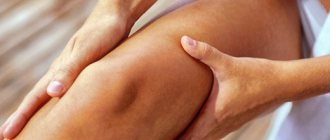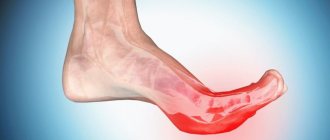When your legs below the knees itch regularly, it does not happen for no apparent reason. Human skin is very sensitive to external influences and changes in biochemical processes within the body. With proper diagnosis, the problem of itching can be quickly eliminated with the help of medications and folk remedies.
The reasons why legs below the knees itch can range from allergies to changes in biochemical processes
Etiology
Not only diseases, but also physiological factors can lead to an itchy leg. It is for this reason that all sources of such a characteristic are usually divided into appropriate groups.
Among the pathological processes occurring in the body, it is worth highlighting:
- diabetes mellitus - with this disease, itching is often observed throughout the entire skin, but most often the legs in the area below the knees are affected by this manifestation;
- liver ailments - hepatitis of any nature or cirrhosis of the liver lead to bile entering the bloodstream. Against this background, the skin acquires a yellowish tint, and almost all patients complain of itching of the skin, in particular in the lower extremities;
- dysfunction of the endocrine system;
- varicose veins of the lower extremities - itching with varicose veins of the legs occurs due to the long-term occurrence of such a disorder. This occurs due to disruption of the venous outflow process on an ongoing basis. In turn, this leads to the fact that an unpleasant sensation is observed at any time of the day;
- infectious diseases, for example, chicken pox and lichen, rubella and measles, as well as scabies;
- pathologies of the nervous system, which are most often caused by an inflammatory process in the nervous tissue or poisoning by toxic or noxious substances;
- vasculitis;
- the presence of a degenerative process in the knee joint;
- skin diseases such as dermatitis, psoriasis, fungal infections or eczema;
- allergies – household chemicals, as well as incorrectly selected household chemicals, are often irritants;
- the course of cholinergic urticaria, which is better known as miliaria. With excessive sweating, itchy skin on the legs can last from thirty minutes to two hours;
- deep vein thrombosis;
- restless legs syndrome;
- diseases of the blood vessels, which cause capillary fragility and minor hemorrhages, which is the source of itching;
- disruption of the normal functioning of organs such as the liver, kidneys and gallbladder;
- blood diseases, namely polycythemia vera, are considered the rarest etiological factor for why legs itch.
Varicose veins are a possible cause of itchy skin on the legs
Physiological causes of itchy skin of the feet are presented:
- prolonged exposure to stressful situations or severe nervous strain;
- taking a shower or bath that is too hot. It is noteworthy that the stronger the influence of heat, the more itchy the toes or feet will be;
- abuse of certain groups of drugs;
- the period of bearing a child - most often itching during pregnancy occurs starting from the third trimester. In such cases, such a manifestation is not common and develops against the background of an increase in the level of the hormone estrogen, which, in turn, inhibits the movement of bile through the liver;
- insect bites;
- improper diet - this reason often causes the development of an allergic reaction, which is called a food allergy. The most common allergens are citrus fruits, exotic fruits, tea and dairy products, eggplant, carrots and cabbage. Often, allergic itching is caused by consumption of fast food and drinking alcoholic beverages;
- allergies to pets or plants;
- wearing tight and uncomfortable shoes, as well as socks made from low-quality fabrics;
- lack of vitamins in the body and dehydration of the skin, which most often happens in the cold season.
All of the above reasons can be applied to both adults and children.
Skin problems
Skin diseases are the most common cause of itching in the knee area and below. The legs and the front part of the lower leg are the most favorite localization of eczema, an autoimmune disease that is allergic in nature. With eczema, the skin itches so much that a person can experience serious psychological discomfort, and sometimes becomes depressed.
With true eczema, the skin becomes covered in a rash, blisters, becomes wet, and then acquires rough crusts.
An even more common cause of itching is dermatitis. In the summer, dermatitis develops from insect bites and contact with plants. Its other causes vary, from medications to reactions to detergents. Itchy spots appear on the skin, which disappear over time, leaving an area of hypopigmentation.
Other possible skin diseases in which the legs itch from below:
| Pathology | Description and signs |
| Psoriasis | Skin autoimmune non-infectious disease. The skin thickens and becomes covered with gray, yellow, and red plaques. |
| Hives | Allergic pathology. In appearance, large papules on the skin, accompanied by itching, are more often observed in children under 7 years of age. |
| Scabies | Acarodermatitis caused by the scabies mite. The skin is very itchy, covered with small rashes and stripes. |
| Erysipelas | Skin inflammation caused by streptococcus. The skin burns, hurts, there are spots of swelling and blisters on it. |
| Lichen | Infection. In appearance - a clearly defined spot (spots) of pink, red, brown color, flaking. |
| Mycoses | Fungal diseases of the foot and leg. Peeling of the skin, swelling, cracks, erosion. |
More severe skin diseases that may cause itching include melanoma and other types of skin cancer. Of course, they do not go away without a trace - a tumor with jagged edges and an abnormal color appears on the leg.
Symptoms
Severe and persistent skin itching on the lower extremities will rarely be the only clinical manifestation. Most often the main symptom is accompanied by:
- redness and swelling of the skin;
- burning;
- increased dryness and peeling of the skin in the affected area;
- formation of cracks;
- pain syndrome caused by skin damage;
- the appearance of erosions and wounds;
- the formation of blisters that may contain purulent or clear exudate. If a person violates the integrity of the bubbles or they burst on their own, then after a while a crust will form on their surface. In some cases, the discharge may be accompanied by a foul odor.
If the cause of the main clinical sign is an allergy, then in addition to the above symptoms the following will be observed:
- cough;
- severe runny nose.
Allergy symptoms
Such manifestations are quite often mistaken for a cold, which is why contact with the allergen does not stop, which can cause a deterioration in the patient’s condition.
All of the above symptoms are most characteristic of itching on the legs, but the possibility of other specific symptoms of a particular ailment cannot be excluded. For example, with diabetes mellitus there will be constant thirst and a rare urge to urinate, and with diseases of the nervous system there will be frequent mood swings, depression and apathy.
The mechanism of development of unpleasant sensations
First of all, in this case, suspicion falls on skin irritation that has arisen for some reason.
But this is not an independent disease, as many believe, but a symptom of some pathology, accompanied by accelerated peeling of the skin. That is why, if itching of the legs appears below the knees, you should consult a specialist. It will help you understand why your legs below the knees itch in a particular situation and how dangerous this negative phenomenon that develops on the lower leg is. The reasons why irritation, “itching” or swelling may develop at a distance from the kneecap to the foot are very different. They can be simple and easily remedied, or quite serious. In the latter case, the skin on the legs below the knees that begins to itch involuntarily is a direct signal from the internal organs about the pathology developing in them. The most common causes of itching of the lower extremities, which often turns into an unbearable burning sensation, are the following:
- dermatological reasons associated with the development of skin diseases;
- allergic reactions;
- infection with opportunistic fungi;
- nutritional system and diet disorders;
- household factors.
First of all, you should consider the simplest, non-hazardous and easily removable causes of itching. Among them, excessive dryness of the skin appears in first place. Also, the constant desire to scratch the limbs also arises due to the reaction of the skin to the synthetic fabric from which the wearable items in contact with the legs are made.
This problem especially often occurs in women who prefer to wear nylon tights in the autumn-winter period, when the ambient temperature level is very low. All these factors can be easily corrected on your own, after which the itching of the legs and discomfort will quickly disappear.
[[!ms2Gallery]]
It is almost impossible to mistake the appearance of pathological discomfort in the lower extremities, since it has its own characteristics. For the most part, the initial stage of the pathology is characterized by the fact that goosebumps begin to run under the knee and the skin in this area itches slightly. Usually these sensations occur in the evening, and at first no additional unpleasant signs appear except for them. However, if you do not seek medical advice and do not start treatment, then very soon the following negative signs will join the goosebumps:
- Itching and burning, similar to as if boiling water had been poured onto the skin.
- Sudden, throbbing pain that affects the foot. It can last a few minutes, or it can last all day.
- The final stage of the development of the pathology, if a person with negative symptoms ignores treatment, becomes an unbearable burning sensation, as well as a feeling that the knee is being twisted.
At best, an insect bite provokes constant scratching of the lower extremities, but if the bloodsuckers definitely did not touch you, then this may be associated with the following symptoms:
- Dry skin. Shaving, hard running water or dry air. The problem lies in improper foot skin care. It is necessary to choose moisturizing lotions or cream soufflés that are suitable individually for you.
- Stress. Often, when nervous, unconscious mechanical movements are made, including scratching the legs. Try to relax, control your actions.
- Frostbite. Signs of the first degree of frostbite may not be noticed - pallor, turning into a red tint when warm, and itching begins.
- Infectious diseases. Even a slight fungus can spread from the area of the feet to the lower extremities, which will bring the desire to scratch, so make it a habit not to wear someone else's shoes and not to walk barefoot outside the house.
In the absence of any diseases, in winter the skin of the legs itches, flakes and becomes dry. The skin is exposed to cold weather, and the body runs out of vitamins and minerals accumulated over the summer. Therefore, legs itch below the knees more often in winter than in the warm season.
Diagnostics
To find out the cause of severe itching, an integrated approach will be required. First of all, the dermatologist needs to independently perform several manipulations, including:
- familiarization with the medical history and life history of the patient - quite often this helps to identify the most characteristic etiological factor for a particular patient;
- a thorough physical examination of the affected area;
- a detailed survey of the patient - in this case, this is an activity of primary importance, since it helps to establish the first time and intensity of the severity of the main symptom and, importantly, to find out the presence of additional symptoms.
Laboratory research involves:
- general and biochemical blood test - for possible detection of the course of a bacterial or infectious disease;
- clinical analysis of urine;
- microscopic studies of feces;
- laboratory studies of a small piece of the patient’s skin, taken by scraping directly from the affected area. This procedure will make it possible to determine the type of fungus that could lead to such unpleasant symptoms.
Instrumental examinations are aimed at identifying dysfunction of a particular internal organ, which necessitates the following:
- radiography and ultrasound;
- CT and MRI;
- endoscopic diagnostic procedures.
After a dermatologist has examined the data from the primary diagnostic measures, the doctor may prescribe additional consultation and examination with:
- gastroenterologist;
- endocrinologist;
- infectious disease specialist;
- neurologist;
- allergist;
- an obstetrician-gynecologist - only in cases of itching on the legs during pregnancy.
This or that specialist will prescribe specific laboratory and instrumental diagnostic measures and draw up a diagram of how to remove such a symptom.
How to get rid of itching below the knees using traditional methods
In addition to the main treatment, you can make home remedies using traditional recipes.
- Mix St. John's wort, chamomile and mint in equal quantities, steam with boiling water and add to the bath. Carry out the procedure daily.
- Lubricate the affected area with castor or sea buckthorn oil
- Make apple cider vinegar lotions 3 times a day.
- Boil the dill seeds. After cooling, take the decoction 3 times a day, half a glass.
https://www.youtube.com/watch?v=58pAiyiwlHE
It is important to first establish why your legs below the knees itch, and then decide how to cure the disease. You cannot prescribe medications on your own.
Treatment
Elimination of itchy skin of the legs is conservative in nature and often includes:
- use of medications in the form of ointments or creams;
- maintaining a gentle diet;
- physiotherapy;
- use of traditional medicine recipes.
For each patient, depending on the etiological factor, an individual treatment strategy will be drawn up. For example, during pregnancy you can get rid of itching by:
- regularly taking showers two or more times a day;
- treating feet in areas of concern with cosmetic oils;
- daily use of activated carbon at the rate of one tablet per ten kilograms;
- drinking plenty of liquid, but not sweet carbonated drinks;
- timely moisturizing of the skin.
If itching occurs with varicose veins of the legs, your doctor will tell you what to do. Often such patients are shown:
- wear compression tights or stockings;
- walk as much as possible;
- treat the affected areas with hormonal ointments or creams.
Compression garments for varicose veins
In addition, you can treat itchy legs by:
- use of antifungal drugs;
- changes in eating habits;
- careful selection of washing powders and shower gels that will not cause allergies;
- wearing clothes made from natural fabrics.
Physiotherapeutic procedures may include:
- therapeutic electrosleep;
- cold and hot shower;
- baths and applications with therapeutic mud and other components.
Drug treatment aimed at eliminating this clinical manifestation involves taking:
- sedatives;
- antihistamines;
- anxiolytics.
In addition, patients are prescribed ointments, gels, powders, and creams with an antipruritic effect.
If the above remedies are ineffective, novocaine blockades are used.
Good results can also be achieved using traditional medicine techniques, which involve the preparation of healing decoctions and infusions that are used for foot baths or lotions. You can cure itchy feet with:
- apple cider vinegar;
- valerian and licorice root;
- burdock and burdock;
- violets and lemon balm;
- juniper and marjoram;
- garlic and dill;
- baking soda.
It is necessary to use traditional medicine recipes twice a day - morning and evening until the symptom completely disappears. It is best to use an integrated approach in treatment.
It is worth noting that the above recommendations are aimed at neutralizing the itching, and not the disease that caused it.
If your feet itch and turn red
If your feet are itchy and covered with red spots, then this may be a symptom of erysipelas. The disease threatens the development of elephantiasis, as it impairs lymphatic drainage.
Erysipelas are caused by streptococci. At first, a person simply begins to feel unwell and his body temperature increases. The appearance of a red spot on the leg is a secondary symptom of the disease, or its relapse. Moreover, it can happen even 6 months after the first episode of inflammation.
The spot is slightly swollen and painful. At first it hurts, and then it starts to itch.
Treatment of the disease requires antibiotics. As a rule, improvement occurs quickly, within 24 hours from the start of therapy. The stain should be smeared with creams with an antibacterial effect. Antihistamines are also indicated to help eliminate the symptoms of the disease.
Prevention
To avoid problems with itchy feet, you must:
- lead a healthy and active lifestyle;
- eat properly and balanced;
- avoid emotional turmoil if possible;
- completely eliminate contact with the allergen;
- wear only comfortable shoes;
- take medications strictly following the doctor’s instructions;
- undergo a full medical examination several times a year.
As for the prognosis of itching on the legs, an integrated approach ensures that the patient gets rid of such a clinical manifestation in a fairly short period of time.
Why do my legs itch after hair removal?
Why do my legs itch after hair removal? title=»{amp}gt;Why do my legs itch after hair removal?
Shaving your legs can cause skin irritation. It begins to itch and becomes covered with red spots. To reduce the likelihood of inflammation, it is necessary to change machines more often and not use them for years.
The razor should be sharp so as not to injure the skin. You can use machines that are equipped with a special strip soaked in aloe extract. This will soothe the skin after shaving and also has a slight disinfectant effect.
During the procedure, it is best to use special shaving products rather than soap. These can be creams and foams. It’s good if they contain vitamin E or aloe vera. The use of such products helps to avoid skin irritation and itching. The procedure should be carried out in the bathroom or shower, as warm water removes hair better.
You should not shave your legs right before leaving the house. If you then put stockings on your feet, the likelihood of itching increases. It is best to remove hair in the evening so that the skin has time to regenerate.
You should not shave your legs in the direction of hair growth. This increases the likelihood of irritation.
Other Possible Causes
It also happens that the cause of itching is a banal insect bite, most often a mosquito. In such cases, sometimes, in addition to itching, there is excessive redness and swelling.
Itching can also be the result of a burn or frostbite, since this kind of thermal effect excites receptors on the skin, which provokes itching.
Oddly enough, representatives of the fairer sex often face this problem. Why do women's calves itch? Usually the reason for this is the desire for beauty. Wearing high heels, synthetic tights and socks, frequent depilation - all this provokes irritation on the legs.
Doctors advise wearing orthopedic, comfortable shoes that will not put pressure on the lower limbs. Since it is usually due to poor blood circulation as a result of compression that itching occurs. This may also be accompanied by other dangerous pathologies, such as hallux valgus, flat feet and others.
Some patients complain that discomfort occurs in the evening. Why do my lower legs itch in the evening? And this is precisely the result of squeezing the lower extremities.
Shoes should be comfortable and moderately loose so that air can flow to the feet and the blood circulation process is not disturbed.

